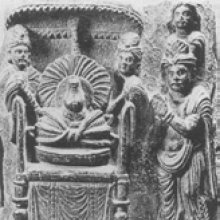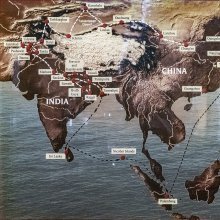Peshawar: 6 definitions
Introduction:
Peshawar means something in Buddhism, Pali, Hinduism, Sanskrit, the history of ancient India. If you want to know the exact meaning, history, etymology or English translation of this term then check out the descriptions on this page. Add your comment or reference to a book if you want to contribute to this summary article.
Images (photo gallery)
In Hinduism
General definition (in Hinduism)
Source: WikiPedia: HinduismThe history of Peshawar, a region of modern-day Khyber Pakhtunkhwa, Pakistan, covers thousands of years. The region was known as Puruṣapura in Sanskrit, literally meaning "city of men". Vedic mythology refers to an ancient settlement called Pushkalavati in the area, after Pushkal, presently known as Charsadda. In recorded history, the earliest major city established in the general area of Peshawar was called Puruṣapura (Sanskrit for City of Men), from which the current name "Peshawar" is likely derived and was western capital of Ghandhara civilization after Pushkalavati.
In Buddhism
General definition (in Buddhism)
Source: Wisdom Library: BuddhismPeshawar refers to one of the places visited by Dharmapāla during his tour of North India. Anāgārika Dharmapāla (born 1864) was a Ceylonese Buddhist who travelled across India and beyond, spreading Buddhism. According to Bhikkhu Sangharakshita in his Biographical Sketc, “he travelled as a pilgrim, not caring at all for comforts, mixing with the sanyasins, ascetics, Hindu pilgrims, and with passengers of the third and intermediate classes, eating at times the poorest food, sleeping at times in places where the poor sleep and gaining an insight into the characteristics of the poor classes, who are suffering from intense ignorance, superstition and poverty”.
Source: WikiPedia: BuddhismPeshawar formed the eastern capital of the empire of Gandhara under the Kushan emperor Kanishka I who reigned from at least 127 CE and, perhaps, for a few years prior to this. Peshawar also became a great centre of Buddhist learning. Kanishka built what was probably the tallest building in the world at the time, the giant Kanishka stupa, to house the Buddha's relics, just outside the Ganj Gate of the old city of Peshawar.
India history and geography
Source: archive.org: Geography in Ancient Indian inscriptionsPoṣa-pura is identical with modern Peshawar, now in Pakistan. At a distance of seventeen miles north-east of Peshawar lies the ancient ruins of Puṣkalāvatī, the ancient capital of Gandhāra country and which is represented now by a huge mound of great height at Charsadda. Hiuen-tsang in his accounts of travel refers to both the places, that is Peshawar and Puṣkalāvatī.
Source: archive.org: Personal and geographical names in the Gupta inscriptionsPeshawar is another name for Puruṣapura: a place name ending in pura mentioned in the Gupta inscriptions. Puruṣapura is transformed into Peshawar in the way that pura is changed to war.
Source: Wikipedia: India HistoryPeshawar (a region of modern-day Khyber Pakhtunkhwa, Pakistan) was known as Puruṣapura in Sanskrit, literally meaning “city of men”. Vedic mythology refers to an ancient settlement called Pushkalavati in the area, after Pushkal, presently known as Charsadda. In recorded history, the earliest major city established in the general area of Peshawar was called Puruṣapura (Sanskrit for City of Men), from which the current name “Peshawar” is likely derived and was western capital of Ghandhara civilization after Pushkalavati
The inhabitants of Peshewar were mostly Hindu and Buddhist before the arrival of Islam and Christianity. Peshawar formed the eastern capital of the empire of Gandhara under the Kushan emperor Kanishka I who reigned from at least 127 CE and, perhaps, for a few years prior to this. Peshawar also became a great centre of Buddhist learning.

The history of India traces the identification of countries, villages, towns and other regions of India, as well as mythology, zoology, royal dynasties, rulers, tribes, local festivities and traditions and regional languages. Ancient India enjoyed religious freedom and encourages the path of Dharma, a concept common to Buddhism, Hinduism, and Jainism.
See also (Relevant definitions)
Full-text (+1): Purushapura, Gandhara, Poshapura, Kunti, Kanishkastupa, Darada, Nandivardhana, Northern India, Abhisari, Helaute, Mangalapura, Kutapala, Buner Reliefs, Asanga, Panini, Lampaka, Kanishka, Vasubandhu, Kantaram, Revata.
Relevant text
Search found 22 books and stories containing Peshawar; (plurals include: Peshawars). You can also click to the full overview containing English textual excerpts. Below are direct links for the most relevant articles:
Indian Medicinal Plants (by Kanhoba Ranchoddas Kirtikar)
66. Hypecoum procumbens, Linn. < [Fumarioideae / Fumariaceae (fumitory family)]
6. Ranunculus soleratus, Linn. < [Ranunculaceae (buttercup family)]
Frontier Mail < [October – December, 2000]
The Nightingale of India: Some Memories < [October – December, 1979]
Bamiyan Buddhas < [October – December, 2001]
A Manual of Khshnoom (by Phiroz Nasarvanji Tavaria)
Anāgārika Dharmapāla (by Bhikkhu Sangharakshita)
Sanskrit sources of Kerala history (by Suma Parappattoli)
The Padmaneri Grant of Venkatapati I < [Chapter 1 - Historical details from Sanskrit Inscriptions]
A Record of Buddhistic Kingdoms (by Fa-Hien)

